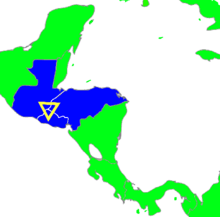Northern Triangle of Central America
The Northern Triangle of Central America is the three Central American countries of Guatemala, Honduras, and El Salvador.
.png)

The term is used with respect to the countries' economic integration,[1] and their shared challenges, including widespread poverty, violence, and corruption, which have prompted many to become refugees fleeing the three nations.[2]
The Northern Triangle is one of the Western Hemisphere's poorest regions; as of 2018, all three countries were in the bottom 20% of Latin American nations by GDP per capita. An estimated 60% of Hondurans and Guatemalans subsist below their national poverty lines in those countries, much higher than other Latin American nations. Collectively, remittances make up nearly 18% of the Northern Triangle's economic output.[2] The group of countries has signed trade agreements with Colombia,[3][4] the United States, and Mexico. The agreement with Mexico began in 2001, later involved the Mesoamerica Project, and expanded to Costa Rica and Nicaragua in 2011.
The Northern Triangle has struggles with chronic violence, attributable to longstanding civil war and political instability in the region and expansive criminal networks, such as the transnational criminal organizations, including 18th Street (M-18) and Mara Salvatrucha (MS-13).[2] Harsh anti-crime policies, enacted by Northern Triangle governments starting in the early 2000s, in most cases failed to reduce crime and may have backfired by dramatically expanding prison populations, a fertile ground for gang recruitment.[2] This region has one of the highest rates of intentional homicide for a country. According to the United Nations, in 2016 there were 27.26 homicides per 100,000 inhabitants in Guatemala, 82.84 in El Salvador, and 56.52 in Honduras.[5] The homicide rate declined somewhat by 2019—with 22 homicide per 100,000 inhabitants in Guatemala, 51 per 100,000 inhabitants in El Salvador, and 40 per 100,000 inhabitants in Honduras—but remained markedly high.[2]
The Northern Triangle has also experienced high rates of both immigration and migration. Research conducted by the PEW Research Center found that between the years 2007 and 2015, the number of immigrants from this region into the US has risen by 25%[6] According to surveys and other research conducted in this region, the majority migration and immigration levels can be attributed to the social, economic and environmental plight they face.[7][8]
See also
References
- Cali, Casa Editorial El País. "Centroamérica, un triángulo de miedo y muerte". elpais.com.co (in Spanish). Archived from the original on 2014-07-26. Retrieved 2018-06-25.
- Amelia Cheatham, Backgrounder: Central America's Turbulent Northern Triangle (last updated October 1, 2019).
- "Tratado de Libre Comercio entre la República de Colombia y las Repúblicas de el Salvador, Guatemala y Honduras". www.tlc.gov.co (in Spanish). Retrieved 2018-06-25.
- República, Presidencia de la. "Colombia y el Triángulo del Norte - Comercio, Inversión y seguridad". Presidencia de la República (in Spanish). Retrieved 2018-06-25.
- "Intentional Homicide Victims | Statistics and Data". dataunodc.un.org. Retrieved 2019-07-03.
- "Immigration From Guatemala, Honduras, El Salvador Up". Pew Research Center's Hispanic Trends Project. 2017-12-07. Retrieved 2020-04-06.
- "Climate Migration in Latin America: A Future 'Flood of Refugees' to the North?". Climate Diplomacy. 2015-04-11. Retrieved 2020-04-06.
- "Central America's Turbulent Northern Triangle". Council on Foreign Relations. Retrieved 2020-04-06.